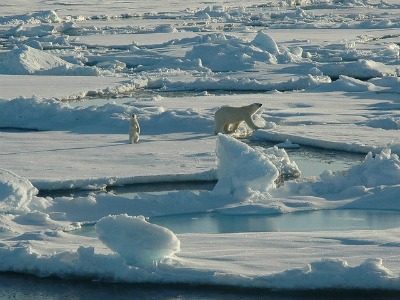
State Fails to Get Oil and Gas Leasing Right

Polar bear and cub on first year ice floes in the Beaufort Sea. Photo: The Hidden Ocean, Arctic 2005 Exploration, NOAA/OAR/OER
Oil and gas projects permitted by the State must comply with the strong protections in Article VIII of the Alaska Constitution. The public has the right to have a say in decisions that impact our public trust resources before those decisions are made. Trustees for Alaska attorneys are finding that is not happening.
Specifically, there is an oil and gas project in Smith Bay, which is in an ecologically rich coastal area of the National Petroleum Reserve-Alaska near Teshekpuk Lake. This area is home to many different species of birds, fish, and marine mammals. The Ikpikpuk River, which drains into Smith Bay, is both pristine and important to wildlife—it supports a large snow goose breeding colony.
STATE OIL AND GAS PROGRAM
The State currently reviews oil and gas projects in “phases.” That means piecemeal review where each step of oil and gas projects is evaluated separately: leasing, exploration, development, production, and transportation. For example, when the Alaska Department of Natural Resources (DNR) makes the decision about whether leasing is in the best interests of the State, it only looks at the impacts of leasing, not at the impacts of exploration, development, or later phases together. This means that DNR never fully considers the impacts of an entire oil and gas project from start to finish and, as a practical matter, never fully evaluates the cumulative impacts of exploration and development.
The legal problem with this approach is that the Alaska Constitution protects public resources and the public’s ability to participate in resource decisions .
TRUSTEES’ PAST SUCCESS
In 2010, Trustees represented a group of Alaska Native and conservation organizations in a challenge to DNR’s phased approach. In that case, DNR made a best interest finding decision for the 2-million-acre Beaufort Sea area, finding that leasing the entire area was in the best interests of the State. DNR did not look at the environmental, socioeconomic, and cumulative impacts of the later phases. Trustees argued that DNR’s approach did not comply with the Alaska Constitution’s requirements for public land decisions and public participation.
The case went all the way to the Alaska Supreme Court. And we won! In Sullivan v. Resisting Environmental Destruction on Indigenous Lands, 311 P.3d 625 (Alaska 2013), the Court said that DNR must look at the impacts of a project, including the cumulative impacts, through all of the phases.
The Court ruled that DNR had to do an impacts assessment and allow for meaningful public involvement prior to approving the various phases.
DNR is constitutionally required to consider the impacts of exploration and development and allow for public notice and comment on those impacts before allowing any activity to occur.
DNR FAILS TO UPHOLD CONSTITUTIONAL REQUIREMENTS
Currently, a company called Caelus is moving forward with exploration on oil and gas leases in Smith Bay. This is one of the first cases where DNR is interpreting and implementing the Supreme Court’s decision, making it very important for the agency to get it right — to properly analyze the impacts and get public input to protect Smith Bay and the Beaufort Sea.
Before Caelus could proceed with the exploration, DNR had to approve its plan of operations. DNR put the plan out for public comment. But the agency did not provide its analysis of the project’s impacts to the public for review. Imagine being asked to evaluate and comment on whether you agree with a state income tax, but you have been given no data and will not see any analysis before a decision is made. That’s what DNR is doing.
That is not the meaningful public participation required by the Alaska Constitution.
And there is another problem with DNR’s approach. While DNR attempted some analysis, it did not do the required cumulative impacts analysis. Without that, the public, and DNR, does not know what the harm to the land, water, and wildlife will be from the project.
Trustees for Alaska, on behalf of Resisting Environmental Destruction on Indigenous Lands (REDOIL), Northern Alaska Environmental Center, Center for Biological Diversity, the Sierra Club, Alaska Wilderness League, and The Wilderness Society, submitted comments to DNR explaining how DNR’s process for approving Caelus’ exploration program doesn’t comply with the Supreme Court decision. When the agency still did not fix the problem, Trustees filed an appeal to the DNR Commissioner. In the appeal, Trustees argues that DNR’s failure to do an impacts assessment prior to approving the program and its failure to evaluate the impacts, including the cumulative impacts, does not comply with the constitutional requirements set out by the Supreme Court.
The appeal is pending before the Commissioner.


